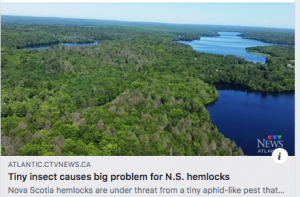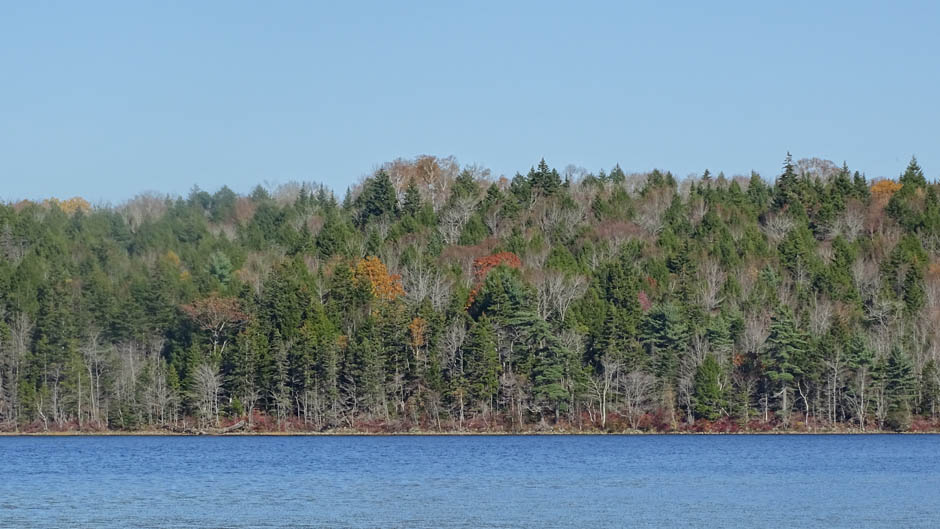Thanks, CTV & Keji Park, for an informative video about HWA in NS, especially given the apparent lack of effort by Lands and Forestry and Big Forestry to raise awareness around it
“Enjoy them now”, says Maria Panopolis introducing CTV’s News’ Nov 8, 2019 piece on the Hemlock Wooly Adelgid (HWA, aka the Hemlock Vampires). Co-host Jason Baxter continues: “We travelled to one of the hardest hit areas, Kejimkujik National Park where ecologists like Matthew Smith are racing against time.”
Dr. Smith explains that hemlock are an iconic tree at Keji; the oldest stands in the park are hemlock. It changes the environment, making it darker and cooler, providing shade for streams; he guesses the oldest trees are 2-300 years old. They survived hurricanes and other pest infestation, but HWA is a real problem for them.
He goes on to provide an illustrated description of HWA, how it infests trees…what symptoms to look for.
“The average Nova Scotian who has a hemlock in their yard or enjoys them in their neighbourhood, is there anything you can do?” asks Jason Baxter.
Smith advises people to contact the Canadian Food Inspection Agency because they are also interested in where HWA is occurring.
Canadian Food Inspection Agency on HWA
The CFIA website offers a page on Questions and Answers: Hemlock Woolly Adelgid (Adelges tsugae) Detection in Nova Scotia with this info on restrictions on movement of wood:
What are the movement restrictions?
Areas regulated for hemlock woolly adelgid are:
- the province of British Columbia
- Digby, Queens, Shelburne, Yarmouth and Annapolis counties in Nova Scotia
The following items cannot be moved out of the regulated areas unless authorized by the CFIA:
- hemlock, yeddo spruce, and tiger-tail spruce:
- plants for planting (i.e. nursery stock, roots, bulbs, seeds and other plant parts)
- forest products with bark attached (i.e. logs, lumber, bark chips, wood mulch)
- dried branches
- Christmas trees
- fresh decorative wreaths, foliage and branches
- firewood of all species
I need to move regulated items. What do I do?
The movement of regulated items out of the regulated area is prohibited unless authorized by the CFIA. Written authorization (e.g. Movement Certificate) from the CFIA is required to move regulated items from regulated areas or to transit regulated items through non-regulated areas. Please contact your local CFIA office for more information.
More details are given in a document D-07-05: Phytosanitary requirements to prevent the introduction and spread of the Hemlock Woolly Adelgid (Adelges tsugae Annand) from the United States and within Canada
There is no info on the CFIA site about pesticides that might be used to protect individual trees.
More detailed info on managing HWA is available in this publicly available review paper:
A decision framework for hemlock woolly adelgid management: Review of the most suitable strategies and tactics for eastern Canada
by Caroline E.Emilson & Michael Stastny of Natural Resources Canada in Forest Ecology and Management Volume 444, 15 July 2019, Pages 327-343
The CTV video closes with Jason Baxter commenting that HWA is ‘Not good news, but something people need to be aware of for sure. So far HWA has only been found in Nova Scotia in 5 counties, not in NB or PEI; there is some hope that pesticides or an introduced predator [could be effective], maybe, but they come with their own risks; and of course climate change is making it worse.
Truly cold winters might kill it off but we don’t really have those anymore especially in the western parts of the province… “here’s a good reason to have a really chilly winter, says Maria P”. (Also for ticks it, might be noted, another pest whose spread into NS has been favoured by climate warming.)
Thanks CTV and Keji Park, for an informative video about HWA, especially given the apparent lack of effort by NS Lands and Forestry and Big Forestry in NS to raise awareness around it, or to provide a Go-To site for people who want to report observations or obtain info on what they can do.
Comments on Social Media
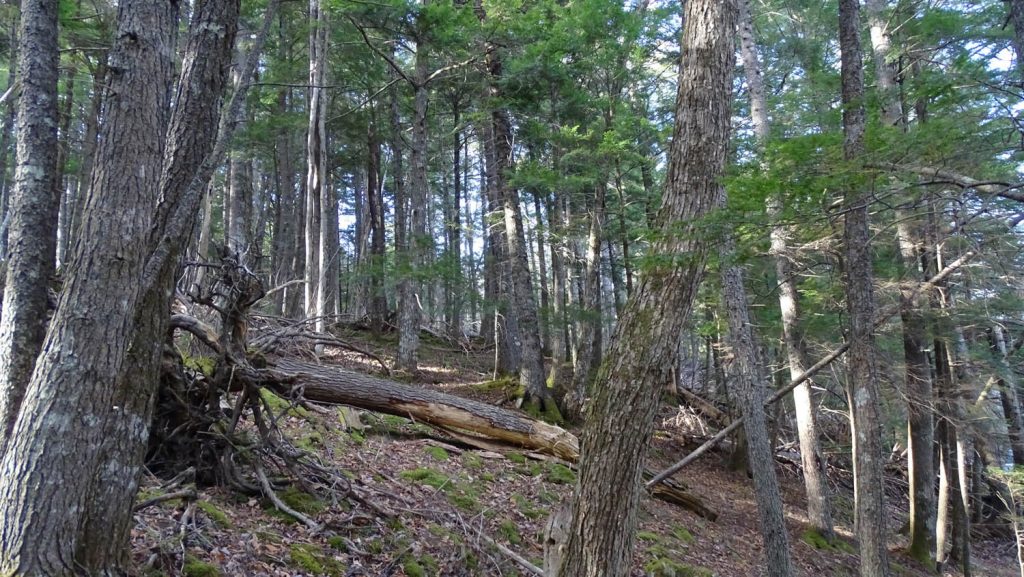
Hemlock-dominated forest on a drumlin by the Sackville River in Halifax Co.
HWA is not there – yet.
Who is talking about a strategy for dealing with post-HWA-Hemlock on sites such as this?
Some comments on Social Media (below): begin diversifying these stands now
Comments on a post about the video on Annapolis Royal & Area – Environment & Ecology (public Facebook group) underscore concerns of citizens about moving wood out of areas in SW Nova Scotia where HWA is now established, how they are already expressing “hemlock nostalgia”, and how they are looking for ways to protect their special hemlock trees:
SES: Well, if they know this and it is predominantly down here in the west end of NS then they have absolutely NO BUSINESS cutting or transporting from here as that will just pass it on to other places. Take a load of so called logs from down here and truck them all the way through the province up the other end, yup that makes sense.
GW: Performing partial harvest treatments in the pure hemlock stands has helped ours diversify. You’ll find red spruce, yellow birch and other species will come in. One thing they missed on there is hemlock like hardwood offer buffering capacity for soils in the form of ph. They keep the soil basic and in turn keep the waterways from becoming acidic
BW to SES – That is precisely my feeling too. To believe that these people know or care anything about bio-security is LAUGHABLE. They don’t give a crap if it spreads all over the place. More trees to SALVAGE cut!!
GW to BW: I’m pretty sure your local mills down there are using it. It’s not used by our larger stud mills.
BW: Probably the same operators doing a lot of the cutting. How well are they cleaning up all of their equipment when they have been working in infected stands? Do you think crews are taking things seriously enough. Blomidon Naturalists made a video showing hikers and naturalists what to do to clean up their clothing and shoes if they discover they have been hiking in an infected forest. Are the logging crews using the same biosecurity measures after working in an infected stand?
GW to BW: I’m not sure but I do know birds are the main mode of transportation. Hard to stop. Diversify the stands… it wont wipe out all hemlocks just like emerald ash borer. Some trees will make it through
BW to GW: I’m hearing some pretty grim stuff out of the New York Hemlock initiative. I guess if we can get enough biocontrol insects in (if and when approved) and inject enough trees with imidicloprid, we might be able to save some. I don’t think it has nearly the survival rate that has been found in Emerald Ash Borer as seen in Ontario. Seems deadlier…Most of the research I’ve seen puts greater blame on human spread than birds.
GW to BW: I think the hemlock interspersed with other species will make it. It’s the pure stands that will be in trouble
BW to GW: I hope that’s true. I have some hemlock on my own property and that’s about all I can count on to protect it.
BW: Infected stands should have been under total quarantine. Now it’s just damage control as it rolls northward across the province.
SES: Well I know out here, they leave the hemlock and take most everything else. Most of their 10 % retention is Hemlock trees
BW: Yes, and soon they’ll be infected and gone.
DW: Is there a reason we don’t introduce bats here ?
BW to DW – Do you mean to repopulate with bats from another place? I think right now, what is hoped is that populations that have survived White Nose Syndrome will have resistance and gradually the colonies will increase (hope I’m answering your question).
DW to BW: yes . Moved here from Ontario and it’s noticeable not seeing bats
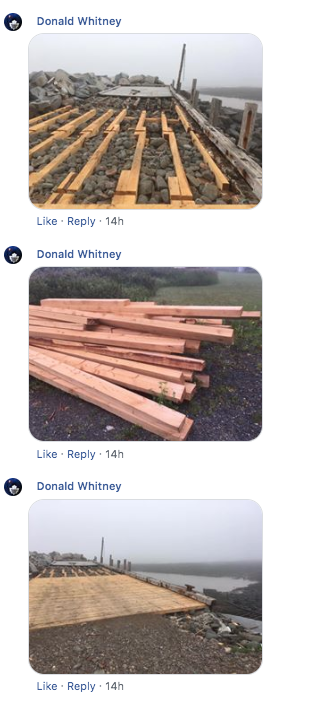
BW: Yes. Nova Scotia seems to have been hit pretty hard with White Nose Syndrome. However, in time, it’s believed they eventually become resistant. I think moving bats around would risk spreading the disease around. They figure a lot of it was spread around by people going cave exploring back before the disease was understood how easily it could be spread on clothing, etc…
DW: 2 local men here in Port George tore up our wharf , milled hemlock and rebuilt it . Tough as them come these , older then me and can lift like ive never been able to lift . Ive so much respect for them . That hemlock , the smell , its like candy . Wonderful smell . What a loss
BW: That’s neat. Glad you took some photos. When I lived in Ontario, a friend bought a bunch of milled Hemlock planks to build the stall dividers in his horse stable. Really tough wood.
DW to BW: a couple of those unsung hero’s nova scotia has . Volunteer
… i took a few family members visiting from ont to that hemlock pile to smell it lol. That poor ranger was so close to tears telling that story eh
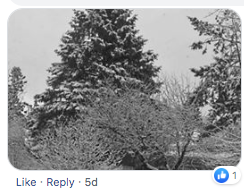 KW: my favorite native conifer. i will be VERY VERY SAD if i lose this beauty in my garden
KW: my favorite native conifer. i will be VERY VERY SAD if i lose this beauty in my garden
BW to KW: – agree. My favourite too. I have that I planted in the front garden near my house. I check then for HWA every few days.
KW: and if you find any?
BW to KW: I don’t know. I think access to the injection stuff is probably not available to joe public. I was thinking I would try something like cleaning vinegar and spray them down – they are small enough that I could do that – 8 feet tall.
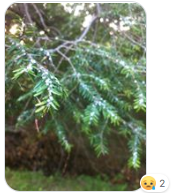 SS: I thought my old friend would be speared. I love this tree. I was very sad this summer to see it on my old friend The babies are not infected yet. I threw myself in front of an excavator that smashed at the bottom limbs. I vowed that day after offering tobacco to protect it. 🙁 i apologized that I did not have the knowledge to help this time and hope that a cure can be found.
SS: I thought my old friend would be speared. I love this tree. I was very sad this summer to see it on my old friend The babies are not infected yet. I threw myself in front of an excavator that smashed at the bottom limbs. I vowed that day after offering tobacco to protect it. 🙁 i apologized that I did not have the knowledge to help this time and hope that a cure can be found.
BW to SS – Aww, I’m very sorry. It’s a very devastating foe and everyone is still struggling to find a way to protect the trees.

